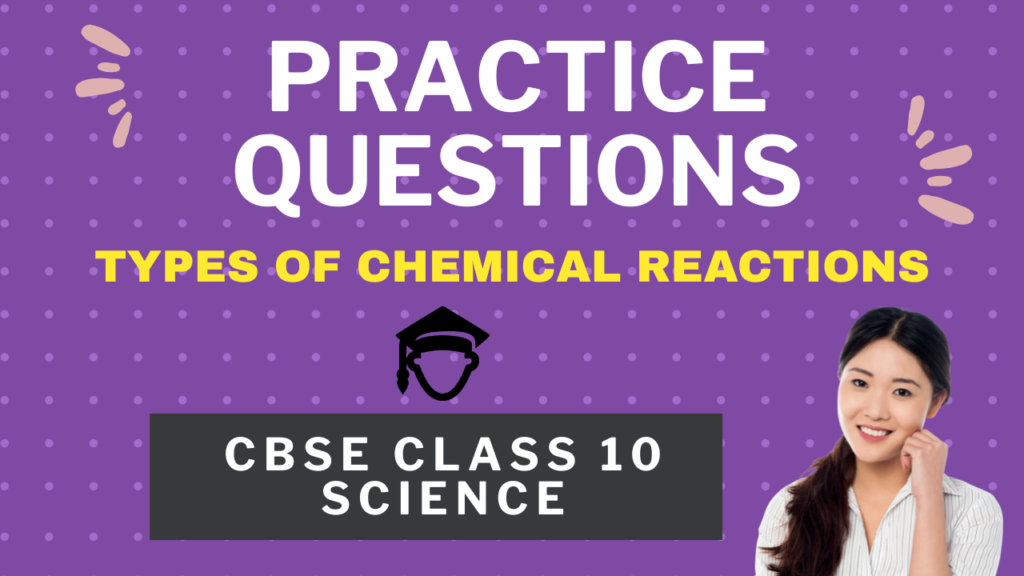Last Updated on July 25, 2025 by XAM CONTENT
Chemical reactions are a fundamental part of chemistry and everyday life. In Class 10 Science, understanding the types of chemical reactions helps you not only score well in exams but also build a strong foundation for advanced learning.
In this post, we provide a brief explanation, followed by 10 exam-relevant practice questions on types of reactions with detailed solutions, based on the latest CBSE Class 10 Science syllabus.
Types of Chemical Reactions – Class 10 Science
Understanding the different types of chemical reactions is a key concept in Class 10 Science. These reactions show how substances interact and change, and practicing problems can help reinforce your learning.
Quick Overview
CBSE Class 10 Science categorizes chemical reactions into the following types:
- Combination Reaction – Two or more substances combine to form a single product.
- Decomposition Reaction – A single compound breaks into two or more simpler substances.
- Displacement Reaction – A more reactive element displaces a less reactive element from its compound.
- Double Displacement Reaction – Exchange of ions between two compounds to form new compounds.
- Redox Reaction – A reaction in which oxidation and reduction occur simultaneously.
- Precipitation Reaction – Formation of an insoluble solid (precipitate) in a double displacement reaction.
Types of Chemical Reaction with examples
1. Combination Reaction- Definition: Two or more substances combine to form a single product.
- General Form:
- Example:
- Definition: A single compound breaks down into two or more simpler substances.
- General Form:
- Example:
- Definition: An element replaces another element in a compound.
- General Form:
- Example:
- Definition: Two compounds exchange ions to form two new compounds.
- General Form:
- Example:
- Definition: A reaction involving oxidation (loss of electrons) and reduction (gain of electrons).
- Example:
- Definition: A reaction in which an insoluble solid (precipitate) is formed when two solutions are mixed.
- Example:
- Exothermic: Reactions that release heat.
- Endothermic: Reactions that absorb heat.
Practice Questions on Types of Chemical Reactions
Practice Questions
- Give one example each of a combination and a decomposition reaction.
- Identify the type of reaction for each:
\[ \text{a) } \mathrm{Na}_2\mathrm{CO}_3 + 2\mathrm{HCl} \rightarrow 2\mathrm{NaCl} + \mathrm{CO}_2 + \mathrm{H}_2\mathrm{O} \]\[ \text{b) } 2\mathrm{KBr} + \mathrm{Cl}_2 \rightarrow 2\mathrm{KCl} + \mathrm{Br}_2 \]\[ \text{c) } \mathrm{AgNO}_3 + \mathrm{NaCl} \rightarrow \mathrm{AgCl} \downarrow + \mathrm{NaNO}_3 \]
- What is meant by a displacement reaction? Give an example.
- Write the balanced chemical equation for the reaction when barium chloride and sodium sulphate react, and name the type of reaction.
- Is rusting of iron an oxidation or reduction? Explain with equation.
- Classify the reactions below as combination, decomposition, displacement, or double displacement:
\[ \text{a) } \mathrm{Zn} + \mathrm{H}_2\mathrm{SO}_4 \rightarrow \mathrm{ZnSO}_4 + \mathrm{H}_2 \]\[ \text{b) } 2\mathrm{KClO}_3 \rightarrow 2\mathrm{KCl} + 3\mathrm{O}_2 \]
- Write an example of a reaction that is simultaneously endothermic and decomposition.
- Balance and identify the type of the reaction:
\[ \mathrm{Fe} + \mathrm{CuSO}_4 \rightarrow \mathrm{FeSO}_4 + \mathrm{Cu} \]
- Why is photosynthesis considered endothermic? Write the balanced equation.
- Balance the reaction and identify the type:
\[ \mathrm{CaO} + \mathrm{H}_2\mathrm{O} \rightarrow \mathrm{Ca(OH)}_2 \]
Answers
-
Combination:
\[ \mathrm{N}_2 + 3\mathrm{H}_2 \rightarrow 2\mathrm{NH}_3 \]Decomposition:\[ 2\mathrm{H}_2\mathrm{O}_2 \rightarrow 2\mathrm{H}_2\mathrm{O} + \mathrm{O}_2 \]
-
a) Double displacement
b) Displacement
c) Precipitation (a type of double displacement) -
A reaction in which a more reactive element displaces a less reactive element from its compound.
Example:\[ \mathrm{Zn} + \mathrm{CuSO}_4 \rightarrow \mathrm{ZnSO}_4 + \mathrm{Cu} \] -
\[ \mathrm{BaCl}_2 + \mathrm{Na}_2\mathrm{SO}_4 \rightarrow \mathrm{BaSO}_4 \downarrow + 2\mathrm{NaCl} \]This is a double displacement and precipitation reaction.
-
Rusting is an oxidation reaction where iron reacts with oxygen to form iron oxide:
\[ 4\mathrm{Fe} + 3\mathrm{O}_2 \rightarrow 2\mathrm{Fe}_2\mathrm{O}_3 \]
-
a) Displacement reaction
b) Decomposition reaction -
Thermal decomposition of calcium carbonate — an endothermic and decomposition reaction:
\[ \mathrm{CaCO}_3 \xrightarrow{\Delta} \mathrm{CaO} + \mathrm{CO}_2 \]
-
Balanced as given, type: Displacement reaction.
\[ \mathrm{Fe} + \mathrm{CuSO}_4 \rightarrow \mathrm{FeSO}_4 + \mathrm{Cu} \]
-
Photosynthesis is endothermic because it absorbs sunlight energy:
\[ 6\mathrm{CO}_2 + 6\mathrm{H}_2\mathrm{O} \xrightarrow{\text{sunlight}} \mathrm{C}_6\mathrm{H}_{12}\mathrm{O}_6 + 6\mathrm{O}_2 \]
-
Balanced combination reaction:
\[ \mathrm{CaO} + \mathrm{H}_2\mathrm{O} \rightarrow \mathrm{Ca(OH)}_2 \]
Detailed Explanations for Select Answers
1. Combination and Decomposition ExamplesCombination: Nitrogen and hydrogen combine to form ammonia.
Decomposition: Hydrogen peroxide decomposes into water and oxygen.
a) Double displacement because ions exchange places.
b) Displacement because chlorine displaces bromine.
c) Precipitation as an insoluble solid AgCl forms.
4. Precipitation ReactionBarium sulfate forms as white precipitate when barium chloride reacts with sodium sulfate:
Iron atoms lose electrons to oxygen forming iron oxide.
7. Endothermic DecompositionCalcium carbonate decomposes upon heating absorbing energy:
Plants absorb sunlight to produce glucose and oxygen:
Frequently Asked Questions (FAQs) on Types of Chemical Reactions Class 10 Science
Q1: Which type of reaction is the rusting of iron?
A1: It is a slow combination reaction and also a redox reaction, where iron combines with oxygen and moisture to form rust.
Q2: Can a single reaction belong to more than one type?
A2: Yes. For example:
$$
CaO + H_2O \rightarrow Ca(OH)_2
$$
This is both a combination reaction (two reactants form one product) and an exothermic reaction (releases heat).
Q3: What is the role of heat or sunlight in decomposition reactions?
A3: They provide activation energy to break down compounds.
Examples:
Thermal decomposition:
$$
CaCO_3 \xrightarrow{\text{Heat}} CaO + CO_2
$$
Photochemical decomposition:
$$
2AgCl \xrightarrow{\text{Sunlight}} 2Ag + Cl_2
$$
Q4: How can I identify a double displacement reaction?
A4: Look for an exchange of ions and the formation of a precipitate or gas.
Example:
$$
Na_2CO_3 + CaCl_2 \rightarrow CaCO_3 \downarrow + 2NaCl
$$
Here, CaCO₃ is a white precipitate — confirming it as a double displacement and precipitation reaction.
Q5: Are redox reactions common in daily life?
A5: Yes. Examples include:
Respiration:
$$
C_6H_{12}O_6 + 6O_2 \rightarrow 6CO_2 + 6H_2O + \text{Energy}
$$
Rusting:
$$
4Fe + 3O_2 + 6H_2O \rightarrow 4Fe(OH)_3
$$
Combustion, battery reactions, and photosynthesis are also redox in nature.



